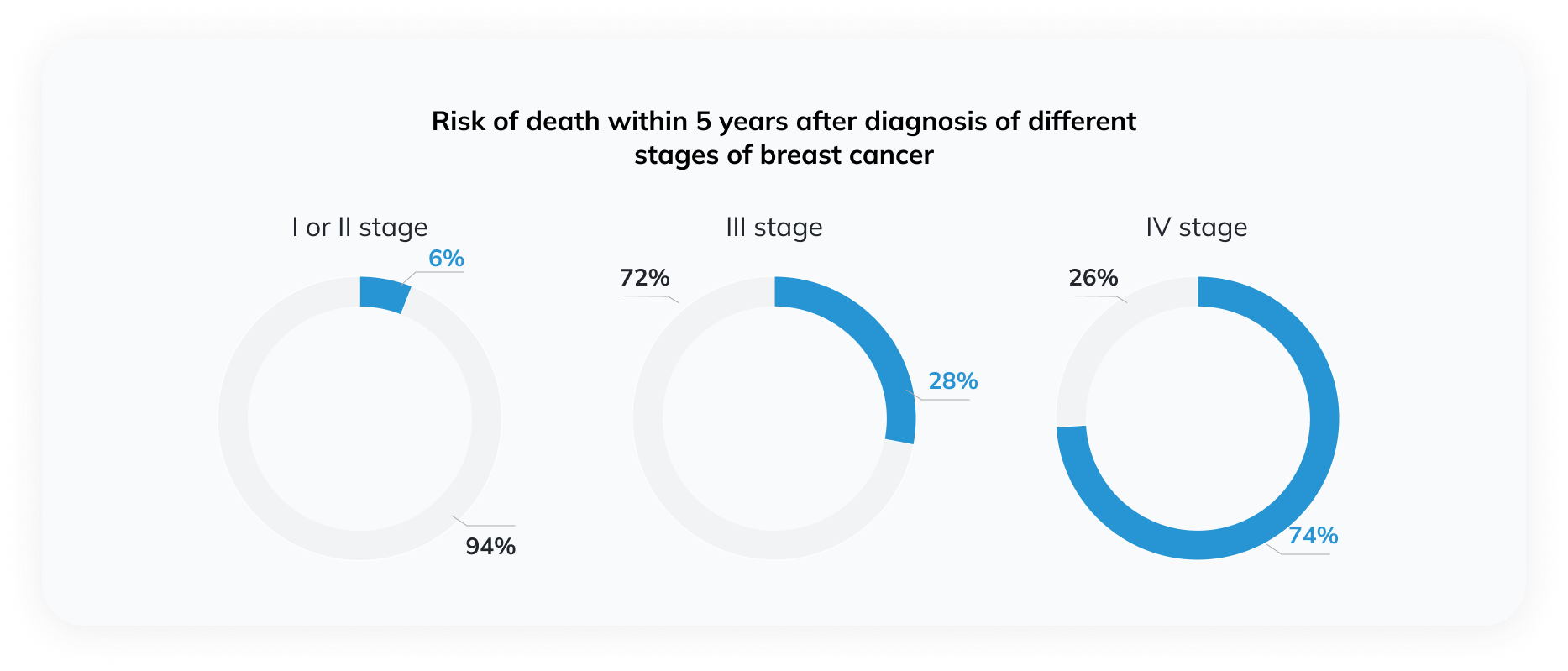Breast cancer
More than 1,600 cases of breast cancer and more than 500 deaths are diagnosed each year. Men can also get breast cancer, but it’s rare – women get it at least 100 times more often. About 10% of breast cancers are due to inherited mutations in genes associated with breast cancer, a condition known as hereditary breast and/or ovarian cancer syndrome (HBOC).
The most commonly studied hereditary cancer risk genes are BRCA1 and BRCA2. Their mutations are the most common. In the absence of mutations in the BRCA1/2, the risk still remains that genetic changes in other, less frequently mutated, cancer-risk genes have been inherited.
Ovarian cancer
About 400 women are diagnosed with ovarian cancer each year. Most women are diagnosed with late-stage cancer and therefore have a high mortality rate. According to the Institute of Hygiene, 263 women died from ovarian cancer in 2020. The exact causes of the development of this disease are not clear. Several factors are known to increase the risk of this disease: early onset of menstruation, late menopause, previous ovarian cysts, recurrent inflammatory diseases of the ovaries, constant consumption of fatty and high-calorie foods. Women who have not given birth, women treated with fertility drugs and using hormone replacement therapy have a higher risk of developing this disease.
Ovarian cancer can be caused by inherited genetic changes. The most commonly studied risk genes are BRCA1 and BRCA2. However, the risk is also increased by mutations in other high- or moderate-risk genes such as RAD51C, RAD51D, BRIP1, and others.
Hereditary breast and/or ovarian cancer syndrome
The risk of developing breast cancer increases with age. By the age of 80, about 10% women have already developed the disease – this incidence is called the general population risk. Not all women are at the same risk of developing cancer. Women who have inherited mutations in cancer risk genes have a higher risk. This inherited tendency to develop breast and/or ovarian cancer is called hereditary breast and/or ovarian cancer syndrome. The risk of developing breast cancer increases the most with mutations in the BRCA1 and BRCA2 genes, which are the most commonly studied. About half of hereditary breast cancers are caused by mutations in other, still rarely studied, cancer risk genes. In addition to BRCA1/2, the clinical practice recommendations of the European Society of Medical Oncology (ESMO) include other breast cancer risk genes: TP53 (p53), PTEN, ATM, PALB2, CHECK2, STK11, CDH1. Once inherited mutations in these risk genes are identified, earlier and more frequent screening for possible breast cancer is recommended. According to the literature, at least ten genes have been identified in which inherited mutations are associated with several or more times higher risk of breast or ovarian cancer.
Symptoms of breast cancer
The most common breast change that suggests cancer is a palpable lump/s in the breast. However, palpable lumps in the breast do not necessarily indicate cancer – they are often benign changes such as breast cysts or fibroadenomas. Other symptoms associated with breast cancer include changes in the shape or size of the breast, swelling of the breast, enlarged lymph nodes in the armpit, breast skin that resembles an orange peel, inverted nipple, rash in the area around the nipple, discharge from the nipple. Sometimes there are no symptoms – this happens when the tumor is small and not yet palpable.
Symptoms of ovarian cancer
Most often, women do not feel any symptoms at the beginning of the disease. As the disease progresses, one may lose appetite, feel fullness in the stomach, begin to lose weight, and experience pain in the lower abdomen. Often, patients complain of defecation and urination disorders, painful intercourse, or bleeding from the genitals.
Breast cancer stages
According to the spread of cancer, there are five stages of breast cancer: from stage 0 to stage IV (4). The lower the stage number, the less spread the cancer is. Stage 0 is non-invasive cancer that has not spread beyond the epithelial tissue. The remaining stages indicate invasive cancer, where cancer cells spread to nearby tissues. Stages I (1) and II (2) are early-stage breast cancer. At these stages, the diameter of the tumor is less than 5 cm. The spread of cancer cells to the adjacent lymph nodes of the breast and axilla is possible, and there are no metastases to other organs. At stage III (3), the tumor diameter exceeds 5 cm, and the tumor can spread to tissues around the breast. Spread to breast or axillary lymph nodes is often observed with no metastases to other organs. At stage IV (4), the tumor metastases to other organs – bones, liver, lungs, and brain. The 5-year survival rate is highly dependent on the stage of cancer: with early diagnosis (stage I or II), survival is >90%, but with stage IV cancer, only a quarter of patients survive (source https://www.cancerresearchuk.org/health-professional/cancer-statistics/statistics-by-cancer-type/breast-cancer/survival#heading-Three ).

Ovarian cancer stages
There are four stages of ovarian cancer – from I (1) to IV (4). The higher the stage number, the more spread the cancer is. Stage I (1) cancer is only found in the ovaries and is considered early-stage. Stage II (2) cancer has spread to the pelvic area. The tumor usually spreads to organs such as the uterus, fallopian tubes, bladder, and rectum. Stage III (3) cancer has spread beyond the pelvic area – into the peritoneum and lymph nodes in the abdominal area. Stage IV (4) cancer metastases to distant organs: liver, spleen, lungs, and lymph nodes outside the abdominal area.
 Working hours
Working hours 